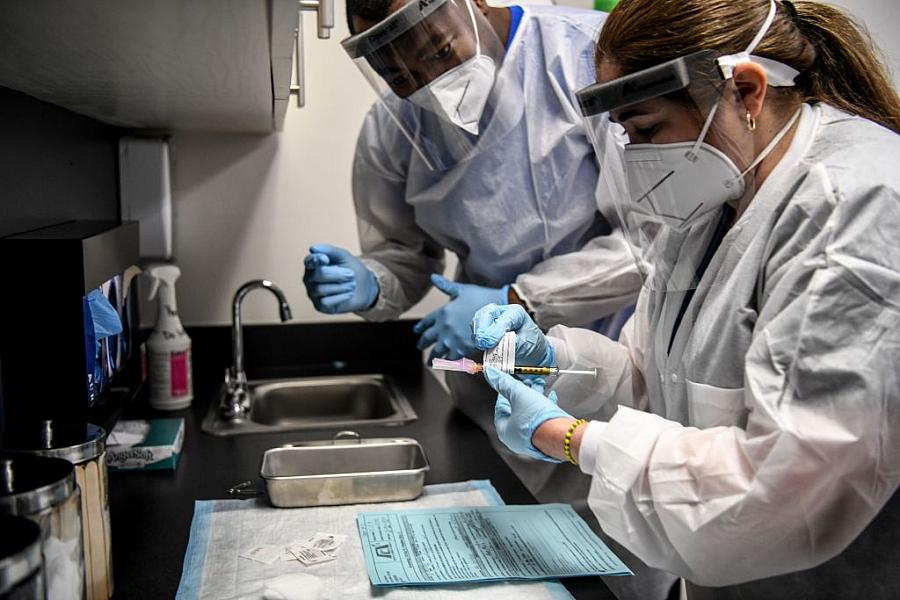As the race for a vaccine enters a crucial lap, keep these reporting tips top of mind

(Getty Images)
With most of the world population still vulnerable to COVID-19, the urgency and scale of the race for a vaccine is unprecedented.
But so are the challenges.
“Just imagine making 7 billion of anything, let alone something as complicated as a vaccine,” said Vox staff writer Umair Irfan in a Center for Health Journalism Covering Coronavirus webinar this week.
The untested science and logistical hurdles of the endeavor are just two of many story lines to track as we near a critical phase in the pursuit of a COVID-19 vaccine. Irfan joined BuzzFeed News’ science reporter Dan Vergano to give an overview of what’s novel about this vaccine effort, key challenges ahead and how to best follow this rapidly developing story.
What’s unique about these vaccines?
The pace of progress and cooperation involved in the COVID-19 vaccine effort are unique, Irfan said.
“Researchers around the world are working together at unheard-of levels,” he said.
On the economic side, governments, philanthropists and businesses are also joining forces, pouring billions into vaccines, which haven’t been traditionally been considered profit engines.
This intense focus and cooperation is delivering tangible results. For example, within two months of scientists sequencing the genome, Moderna dosed the first human with its vaccine candidate, a pace “that’s absolutely bonkers fast,” he said.
Overlapping clinical trials are adding to the speed, he added. At the same time, factories and supply chains are being established to produce and distribute a vaccine that hasn’t yet been approved, with the goal of further compressing the timeline.
New technologies are a factor as well. Moderna’s vaccine, which is already in Phase 3, is noteworthy because it is a gene-based vaccine, a novel technique which could lead to a more robust immune response. The company is relying on messenger ribonucleic acid (mRNA) as the basis for its vaccine, which allowed it to very quickly tweak the code in a strand of mRNA once the novel coronavirus was sequenced. (To go deeper on the science, check our Irfan’s great primer here.)
Following important storylines
Despite these rapid developments, it’s important to keep in mind that that the first approved vaccine likely won’t be an “end-the-pandemic button,” Irfan said. For one, it’s likely we will need more than one vaccine for different people and distinct immune conditions. Supply constraints on any single vaccine also mean it’s better to have more than one successful vaccine. It’s also still unclear how long immunity would last, and how soon a “booster” shot might be needed.
And, even with all these efforts, there’s no guarantee that any vaccine will clear clinical trials. One less covered storyline: How would we cope with no viable options? Most vaccines fail, even those that successfully clear phase II trials. That’s one reason there’s also an intense focus on new therapies such as monoclonal antibodies to treat patients once they’re already infected.
Another angle to track: Virus containment efforts still matter since fewer cases means fewer vaccinations will be necessary to keep the virus at bay when a vaccine does become available.
The scale of the endeavor means there are story ideas everywhere. How do we build, administer and pay for vaccines on a global scale? Will there be enough basic supplies such as syringes and vials? Most vaccines require narrow temperature conditions (Pfizer’s vaccine requires storage at -94° Fahrenheit), which means transporting could present challenges. UPS is already installing freezers in hubs, but much more will need to take place to distribute these vaccines.
Irfan advised reporters to start with your local infrastructure, asking local health officials how nearby facilities will respond to storage and distribution challenges. How are financially strapped municipalities going to handle the potential costs given the budget shortfalls they already face?
History’s lessons
Looking at the H1N1 vaccine rollout offers some cautionary lessons, according to Vergano, who covered that 2009 experience. That vaccine rollout was defined by shortages and surpluses, a pattern which could be echoed with COVID-19.
Once there is a viable vaccine, there initially won’t be enough doses for everyone, which will create tensions in a world where people are dying from the virus, Vergano said.
Another lesson from history: The first Polio vaccine developed by Jonas Salk wasn’t the one eventually adopted a few years later. Similarly, we should be bracing for the possibility of unexpected twists and disappointments ahead.
A certain percentage of the population need to get vaccinated to achieve herd immunity — estimates commonly range from 50% to 70%. Pay attention to the public’s willingness to get vaccinated, which is voluntary. A lot of people who are not traditionally skeptical of vaccines are wary of this one because of the emphasis on speed and the politics involved (Trump clearly sees a vaccine as a key aspect of his re-reelection campaign, he said).
Perhaps the biggest lesson is: “Public opinion is everything,” Vegano said.
There is also a deep-seated distrust in medicine among some minority communities for historical reasons, “a hard one to fix with a promise and a smile,” he said.
As you follow these developments, key agencies to monitor include the Centers for Disease Control, which will set priorities on who get the vaccine first. There will also be public Food and Drug Administration meetings on vaccine candidates, including a potentially newsworthy advisory committee meeting on Oct. 22.
When news breaks, be careful of pulling straight from a company’s press releases, advised Irfan. While science journalists tend to seek outside opinions and offering analysis of the results, he’s seen cases where business reporters inflate minor results and fail to consult their colleagues covering science. He underscored the need for newsroom collaboration when vaccine stories cross the science and business beats.
That consistency builds trust among readers: “You should be on message throughout your coverage.”
**
Watch the full presentation here:

